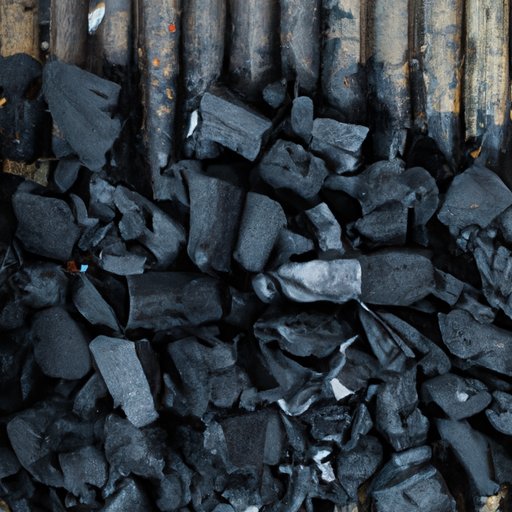
Introduction
When we think of charcoal, we often think of the little black lumps we use to cook our food on the grill. However, charcoal has been around for thousands of years and has a multitude of uses, from blacksmithing to water filtration. Making your own charcoal at home is not only a fun DIY project but can also be cost-effective and eco-friendly. In this article, we will explore the various methods and techniques for making charcoal at home and its benefits.
A Step-by-Step Guide to Making Charcoal at Home
To make charcoal at home, you will need essential materials such as a metal barrel, wood, a shovel, and safety gear. The first step is to select the wood for your charcoal. Hardwoods such as oak, maple, and hickory are recommended for their high carbon content.
Once you have selected your wood, prepare it by cutting it into small pieces and stacking it in the metal barrel. Next, light the wood on fire and cover the barrel with a lid to contain the heat. The key is to maintain a consistent temperature between 400-600 degrees Fahrenheit for several hours. This will allow the wood to break down and release its volatile compounds, leaving behind pure carbon.
It is important to note that charcoal making can be dangerous due to the high temperatures involved and the potential release of toxic gases. Therefore, it is necessary to take safety precautions such as wearing protective clothing and only performing the process in a well-ventilated area.
The Ancient Art of Charcoal Making: How to Do It Yourself
Charcoal has been used for centuries across the globe and has been an essential part of various cultures. Traditional charcoal making involves a pit kiln, which is a large hole dug into the ground surrounded by a chimney. The wood is stacked at the bottom of the pit, and the pit is covered with soil and straw. A small opening at the top allows air to enter the pit, and the wood is burned for several days, producing charcoal.
While traditional charcoal making is still used in some parts of the world, modern methods have also been developed, such as the metal barrel method discussed earlier. Both methods have their pros and cons, with traditional methods being more time-consuming but producing a higher-quality charcoal.
DIY Charcoal: Turn Your Backyard into a Blacksmith’s Haven
Making your own charcoal for blacksmithing can be a cost-effective alternative to purchasing commercial charcoal. The key to making high-quality charcoal for blacksmithing is to have a consistent and uniform burn rate. To achieve this, it is recommended to use dense, hardwood species such as hickory or oak and to ensure a slow and steady burn throughout the process.
It is also important to monitor the temperature of the kiln and adjust it as necessary to achieve the desired quality of charcoal. By making your own charcoal for blacksmithing, you can have full control over the quality and purity of the charcoal, resulting in more efficient and higher-quality work.
Eco-Friendly Fuel: How to Make Charcoal from Natural Materials
Making charcoal from natural materials such as coconut shells, corn cobs, or sawdust is an eco-friendly alternative to traditional charcoal. By using waste materials as a fuel source, you can reduce the carbon footprint and prevent waste from ending up in landfills.
The process of making charcoal from natural materials involves carbonizing the materials through a heating process, like traditional methods. The resulting charcoal can be used in various applications such as fuel for cooking or as a water filtration medium.
Charcoal-making 101: Turning Wood into Fuel for Grilling and More
Charcoal has become a popular fuel source for grilling and cooking due to its superior heat retention and smoke-enhancing properties. Choosing the right type of charcoal for your needs can make all the difference in the flavor and quality of your food.
There are two main types of charcoal: lump charcoal and briquettes. Lump charcoal is made from natural wood and burns hotter and faster than briquettes, making it ideal for grilling. Briquettes, on the other hand, are made from compressed sawdust and other materials and burn at a more consistent temperature, making them ideal for smoking or slow-cooking.
From Branches to Briquettes: A Beginner’s Guide to Making Charcoal
For beginners interested in making their own charcoal at home, there are several simple methods that can be used. One method involves placing small pieces of wood in a metal drum with a hole in it and lighting it on fire. The wood will burn and release volatile gases, leaving behind charcoal.
Another method involves using a pit kiln, as discussed earlier in the article. This method involves digging a hole in the ground, placing the wood inside, and covering it with soil and straw. The wood is burned for several days, and the resulting charcoal is extracted.
Conclusion
Making charcoal at home can be a fun and rewarding DIY project with a multitude of uses. From blacksmithing to cooking and water filtration, the possibilities are endless. By following the step-by-step guide and taking necessary safety precautions, you can produce high-quality charcoal at home and reduce your carbon footprint.





